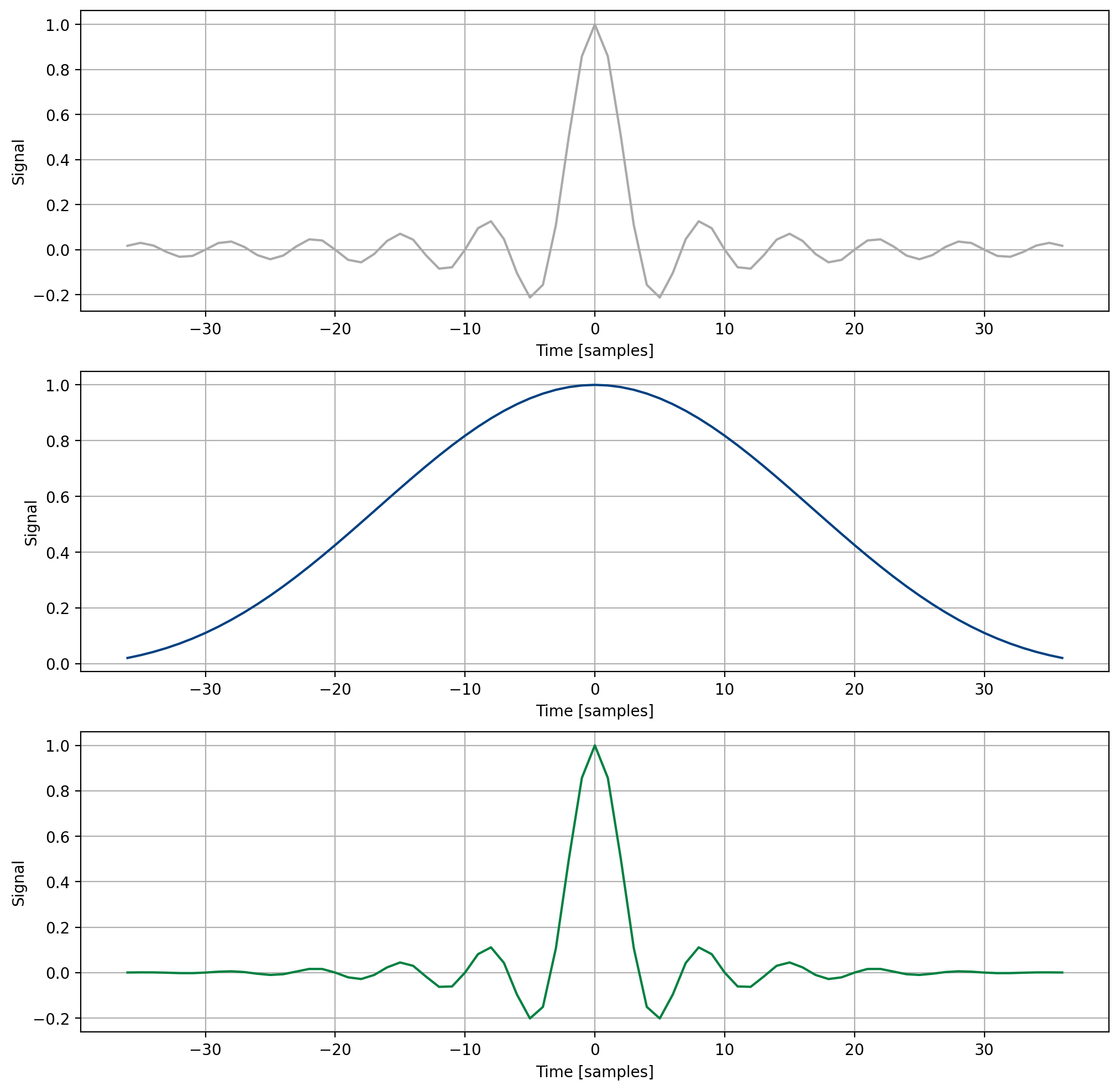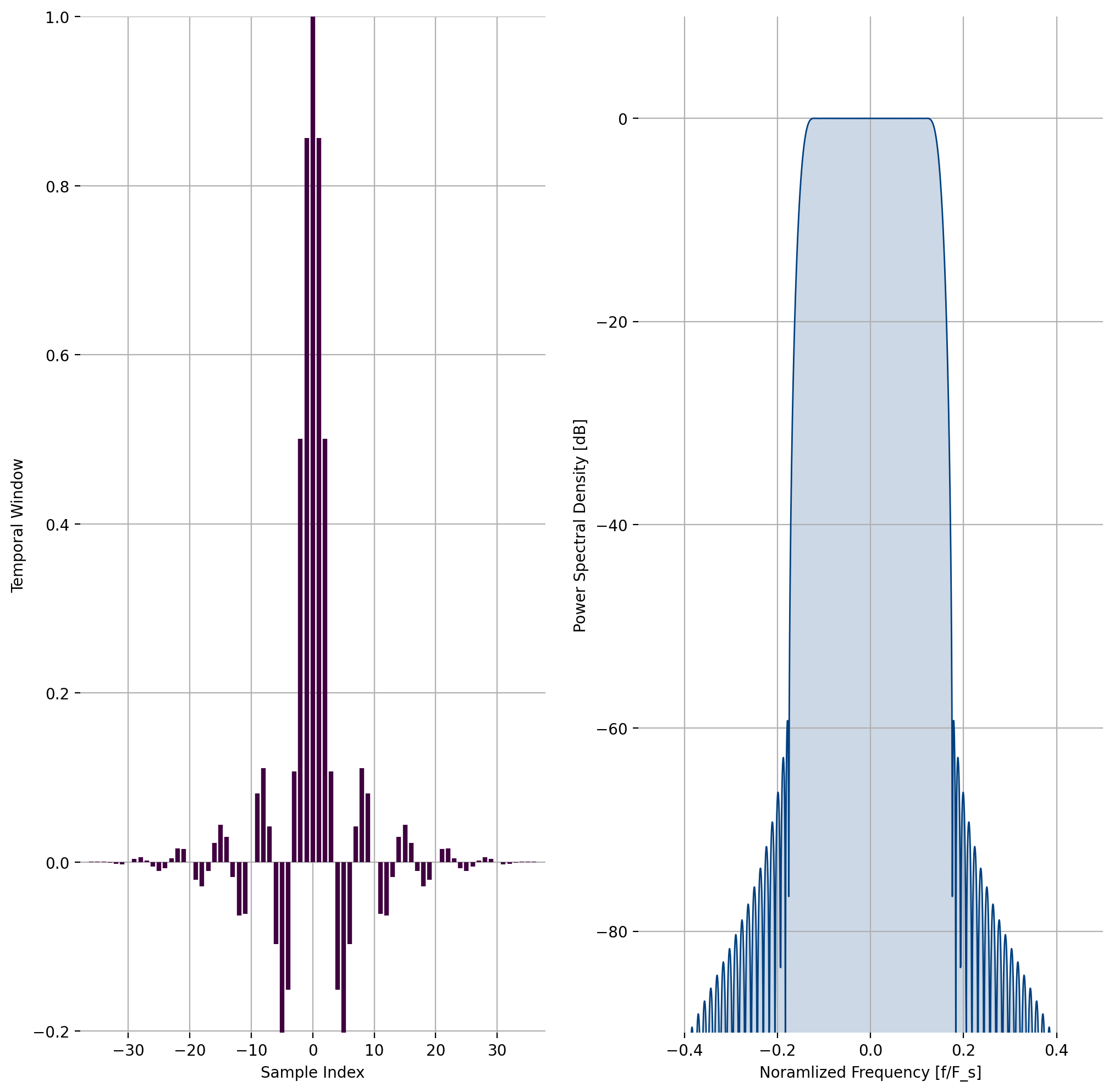Finite Impulse Response (FIR) Design using Windowed sinc¶
The ideal low-pass filter has a rectangular response in the frequency domain and an infinite \(\sin(t)/t\) response in the time domain. Because all time-dependent filters must be causal, this type of filter is unrealizable; furthermore, truncating its response results in poor pass-band ripple stop-band rejection. An improvement over truncation is offered by use of a band-limiting window.
Operation¶
Let the finite impulse response of a filter be defined as
where \(w(n)\) is a time-limited symmetric window and \(h_i(n)\) is the impulse response of the ideal filter with a cutoff frequency \(\omega_c\), viz.
A number of possible windows could be used; the Kaiser window is particularly common due to its systematic ability to trade transition bandwidth for stop-band rejection. The Kaiser window is defined as
where \(I_\nu(z)\) is the modified Bessel function of the first kind of order \(\nu\) and \(\alpha\) is a shape parameter controlling the window decay. \(I_\nu(z)\) can be expanded as
The sum in [eqn-filter-firdes-besseli_infinite_sum] converges quickly due to the denominator increasing rapidly, (and in particular for \(\nu=0\) the denominator reduces to \((k!)^2\)) and thus only a few terms are necessary for sufficient approximation. The sum [eqn-filter-firdes-besseli_infinite_sum] converges quickly due to the denominator increasing rapidly, thus only a few terms are necessary for sufficient approximation. For more approximations to \(I_0(z)\) and \(I_\nu(z)\), see [section-math] in the math module. Kaiser gives an approximation for the value of \(\alpha\) to give a particular sidelobe level for the window as {cite:Vaidyanathan:1993((3.2.7))}
where \(A_s \gt 0\) is the stop-band attenuation in decibels. This approximation is provided in liquid by the kaiser_beta_As() method, and the length of the filter can be approximated with estimate_req_filter_len() (see [section-filter-misc] for more detail on these methods).

Figure 7 Windowed sinc filter design¶
Interface¶
The entire design process is provided in liquid with the
firdes_kaiser_window() method which can be invoked as follows:
int liquid_firdes_kaiser(unsigned int _n,
float _fc,
float _as,
float _mu,
float *_h);
where
_n is the length of the filter (number of samples),
_fc is the normalized cutoff frequency (\(0 \leq f_c \leq 0.5\)),
_As is the stop-band attenuation in dB (\(A_s \gt 0\)),
_mu is the fractional sample offset (\(-0.5 \leq \mu \leq 0.5\)),
and *_h is the \(n\)-sample output coefficient array.
Example¶
Listed below is an example of the firdes_kaiser_window interface.
// demonstrate fir filter design using Kaiser window
#include <stdio.h>
#include <stdlib.h>
#include "liquid.h"
int main(int argc, char*argv[])
{
// options
float fc = 0.15f; // filter cutoff frequency
float ft = 0.05f; // filter transition
float As = 60.0f; // stop-band attenuation [dB]
float mu = 0.0f; // fractional timing offset
// estimate required filter length and allocate buffer
unsigned int h_len = estimate_req_filter_len(ft,As);
float h[h_len];
// compute filter coefficients and print to stdout
liquid_firdes_kaiser(h_len,fc,As,mu,h);
printf("w\n");
unsigned int i;
for (i=0; i<h_len; i++)
printf("%12.8f\n",h[i]);
return 0;
}

Figure 8 Example of liquid_firdes_kaiser¶
An example of a low-pass filter design using the Kaiser window can be found in [fig-filter-firdes_kaiser].